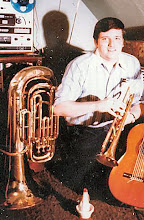
Side 1
1. Walking Through New Orleans
2. Lazybones
3. South
4. Cute
5. Johnson Rag
6. Royal Street Blues
Sde 2
1. In The Mood
2. Careless Club
3. The Mardi Gras Walking Club
4. Ol' Creole
5. Clarinet Marmalade
Liner Notes:
WALKING THROUGH NEW ORLEANS PETE FOUNTAIN
Clarinet Solos With Orchestra
Arranged and Produced by Charles Bud Dant
Pete Fountain - Charles Bud Dant
Walking Through New Orleans is a title of more than ordinary significance to the jazz musicians of the Crescent City, for their participation is essential to the gay parades that are such a joyful feature of the city's life.
At Mardi Gras, a tavern to the south of Canal Street is the rendezvous for Pete Fountain's Walking Club, which each year is outfitted in different costumes. In 1968, for example, Christopher Columbus and his era provided the motif. Honored guests like Phil Harris are welcomed to the club, but are not expected to blow. Other visitors like producer Bud Dant, Eddie Miller and Nick Fatool have been required to display their prowess en route, on peck horn, tenor saxophone and drums respectively. The core of the group, however, consists of those much-experienced walkers, Paul Barbarin and the Onward Brass Band.
Some time around 9 in the morning, this colorful assembly debouches on to the street, marshals itself with casual discipline under Pete Fountain's jovial eye, and sets forth clamorously toward the broad expanse of Canal Street, where it turns right and marches steadfastly in the direction of the reviewing stand. After saluting the dignitaries with music, it turns left and north for a devious perambulation of the French Quarter, its estimated time of arrival at Pete Fountain's Storyville being somewhere in the region of 2 o'clock. There the valiant walkers are refreshed and their thirsts properly assuaged.
Memories of such occasions were the inspiration of this album, which collects material recorded over a five-year period, much of it indigenous to New Orleans, and all of it appropriate to the city's taste and musical inclinations.
The title song is at once an evocation and a re-creation of the parade music. Pete is backed by trumpet, tuba, five trombones, bass, banjo, and a formidable percussion section composed of Jack Sperling, Nick Fatool, Godfrey Hirsch and - with his famous bass drum and cymbal - Paul Barbarin. Careless Love was made the next day with the same musicians, except that Elmer Schneider was the only trombonist and John Propst was added on piano.
The Mardi Gras Walking Club is explained vocally by a small mixed group, and instrumentally by Pete with a first-class rhythm section made up of Stan Wrightsman (piano), Bobby Gibbons (guitar), Morty Corb (bass) and Jack Sperling (drums). The same group is responsible for Royal Street Blues, a dignified performance as befits the title. Despite the formal, familiar framework, and the 12/8 gait, we are reminded that the street is in the French Quarter by some blues playing with the time-honored feeling. In fact, this is also part of the local tradition: to take old tunes as points of departure and arrival, and sandwich the blues in between. But Ol' Creole is all blues, straightahead, unadorned, as conceived by Pete and Bud Dant, and played by the same well adjusted musicians.
Although New Orleans preserves its own jazz tradition more zealously than any other city, it does not exist in splendid isolation away from the rest of the jazz world. Items from outside are selectively incorporated into its preferred repertoire. This accounts for the presence here of two numbers made famous by Glenn Miller - In The Mood and Johnson Rag. The former has a relatively modern, big-band sound, with loose phrasing by the soloists for contrast. Johnson Rag, of course, goes far back, all the way to 1917. South has a somewhat similar past, having been popularized and written by another bandleader, Bennie Moten, in association with his trombonist, Thamon Hayes. They first recorded it in St. Louis in 1924, but this performance, like that of Johnson Rag, was recorded in New Orleans in 1967 by an expanded version of Pete's band, which is heard with its regular personnel on Hoagy Carmichael's Lazybones. Eddie Miller's tenor saxophone opens and closes this, while Pete exercises a leader's privilege in variations. The other musicians are: Joe Serpas and Conrad Jones (trumpets), Jack Delaney and George Prejean (trombones), Earl Vuoivich (piano), Oliver Felix (guitar), Paul Edwards (drums) and Godfrey Hirsch (vibes).
Clarinet Marmalade, oddly enough, had never been recorded by Pete before. Written in 1918 by two members of the pioneering Original Dixieland Jazz Band, it is a natural for the clarinetist, and Bud Dant's arrangement preserves the traditional character. The band is again Pete's current ten-piece outfit, and its interpretation brings our musical walking tour of the city to an ending that is every bit as enthusiastic as the beginning. With this album you can make it again whenever you will.




No comments:
Post a Comment